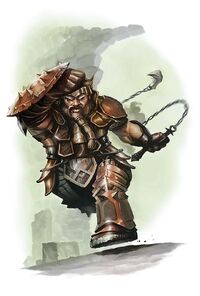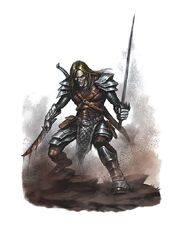Fighter was a descriptive term for a warrior skilled with a variety of weapons and trained in the arts of war. A skilled fighter defined the front line of any battle, breaking through enemy ranks and holding the line while their allies maneuvered. All fighters were trained to use virtually any armor or weapon the situation required; a fighter could use an axe, a rapier, or a greatsword with roughly equivalent skill. As well as being combat generalists, most fighter also specialized in a particular skillset, such as archery or combat magic.[1]
Artemis Entreri, Bruenor Battlehammer, Drizzt Do'Urden and Azoun IV are all well-known fighters from Toril's history.[2]
Culture
Among the most common adventurers, fighters came from an innumerable set of backgrounds. Some were knights in the service of a quest or elite foot soldiers whilst others were ambitious would-be overlords or hardened mercenaries. What brought fighters together, however, was their common roots as warriors who put themselves in the thick of battle, between their comrades and harm's way; while many fighters could be called disreputable, few, if any, were true cowards.[3]
All fighters drew on a wealth of experience built by others who'd come before them, though some had more formal training than others. Many fighters came to their profession through membership in a militia or army, while others acquired their skills in military academies. Others were more or less self-educated, their skills hardened through hard-earned experience rather than formal instruction. Some fighters were brought to the ways of martial combat by a threat to their home and others were a part of a long family tradition.[1] These diverse backgrounds and motivations meant most fighters did not see themselves as part of a greater brotherhood or fellowship. Instead, fighters perceived their friends and brothers in those with whom they'd faced danger together, distinguishing little by profession.[4]
Fighters were common in nearly every part of Faerûn and though they were sometimes overlooked due to their widespread nature, truly skilled fighters were well-respected for their abilities. While many fighters operated on their own or as parts of informally organized groups, others held themselves to a higher ideal and were part of knightly orders. These included such renowned groups as the Purple Dragons of Cormyr, the Knights Kuldar of Barakmordin, or the Champions Vigilant of Helm.[2]
Likewise, fighters came from a wide variety of races. Among humans, dwarves, high elves[4] (particularly moon elves),[2] halflings[5] (lightfoot or strongheart halflings),[2] and dragonborn[5] fighters were particularly common, drawing on the military traditions of each race. Half-orc fighters were also common, though less so, and were typically outcasts among both humans and orcs who'd taken their hardships and channeled it into a force for discipline and martial skill. Among the goblinoid races, hobgoblins were most commonly fighters, the other races typically lacking the discipline for a strong martial tradition.[4] Drow and duergar fighters were also somewhat common.[2]
Abilities
Fighters of all varieties were skilled in the use of the most commonly used weapons and armor, making them highly proficient in the ways of battle.[6] All fighters were adept at both melee and ranged combat, though many fighters put the emphasis of their training on melee.[7] Every fighter had, in addition to their broad knowledge of most weapons, a particular style of fighting that they preferred. Some were specialists in the use of armor or shielding their allies from harm. Others were particularly skilled in the use of great or single-handed weapons. Still others, like rangers, were specialized in the use of ranged weapons or dual wielding.[8]
In addition to their proficiency in the use of particular weapons, fighters had a number of other useful combat abilities. Incredibly durable and courageous, fighters were capable of recovering from blows that might kill other warriors, allowing them to sustain themselves for prolonged stretches of combat. Experienced fighters were likewise more resilient to the effects of poisons, spells, or other debilitating effects. Additionally, fighters could push themselves beyond their normal limits every few hours in a burst of energy, allowing them to act and move more quickly. Similarly, experienced fighters were capable of attacking more quickly, up to about four times as quickly as other warriors.[8]
Many fighters worked best fighting alongside others and were trained to protect the flanks of allies. When an enemy attacked a friend or ally of these fighters, the fighter was prepared to leap to the ally's defense and distract the foe, decreasing the effectiveness of their attacks. Fighters were also better able to take advantage of flaws in enemies' defenses than most other warriors.[9]
Fighter traditions
The qualities and skills of a fighter often varied depending on the precise training each fighter received. Many fighters belonged to one of the following martial traditions.
Battlerager fighter

A battlerager fighter.
Battlerager fighters were an uncommon variety of fighter who preferred to trust their instincts and the thrill of battle to pull them through danger. Thrill seekers who loved the heat of battle, battleragers seemed to only grow more powerful the more they were injured. More so than other fighters, battleragers relied on their strength, which they used to make powerful strikes with their favored weapons such as axes or hammers. However, most also had a strong constitution as well as good instincts, needing both in order to survive the many battles they endured.[10]
Most battleragers, instead of focusing their skills on either one-handed or two-weapon fighters like most fighters, had the ability to ride enemy attacks, channeling their pain into a violent fury. This extraordinary vigor not only allowed them to endure heavy blows longer than most fighters, but also could be channeled into their own attacks, particularly when they were wearing chainmail or lighter armor or were using axes, hammers, maces, or picks, the favored weapons of most battlerager fighters.[10] Those who devoted themselves to enhancing these skills might become ravagers.[11]
Great weapon fighter
Great weapon fighters focused their training on the use of large, two-handed weapons such as greatswords and were better equipped to deal heavy damage than most fighters. Great weapon fighters were hardier than most other fighters, though they tended to be less nimble. Most exploits used by great weapon fighters traded finesse for sheer power, with their focus on subduing a foe as quickly as possible before they could do significant harm to a fighter's allies.[12]
Guardian fighter
Guardian fighters took the oft defensive position of fighters to its extremes, making their shield an integral part of their fighting style. These fighters invariably used one-handed weapons such as longswords or flails, leaving their off-hand free for holding a shield. To these fighters, avoiding damage was as important as dealing it and most were more dexterous than other fighters. Guardian fighters also tended to favor exploits that were either more accurate than those of other fighters or which had additional, debilitating effects for the foes they struck.[12]
Tempest fighter

A two-weapon or “tempest” fighter.
While most fighters preferred to use either large, two-handed weapons or a smaller weapon and a shield, tempest fighters were unusual in that they choose to use two smaller weapons together, one in each hand. This made tempest fighters uniquely versatile, able to deal more damage than most guardian fighters but able to defend themselves better than most great weapon fighters. For these individuals strength remained important but quick instincts and battlefield awareness took on a newfound importance, as did speed and maneuverability. As a result, fewer tempest fighters trained their bodies to the same physical limits of endurance that other fighters usually did.[10]
While not all tempest fighters abandoned the one-handed or two-handed focus that most fighters embraced, most did, and took on training in the so-called “tempest technique,” an expert style of two-weapon fighting. These tempest fighters were adept at defending themselves with dual weapons and found themselves at their best when using chainmail or lighter armor, which gave them a stronger ability to maneuver and deal deadly, two-pronged attacks.[13]
References
- ↑ 1.0 1.1 Mike Mearls, Jeremy Crawford (2014). Player's Handbook 5th edition. (Wizards of the Coast), pp. 70–71. ISBN 978-0-7869-6560-1.
- ↑ 2.0 2.1 2.2 2.3 2.4 Ed Greenwood, Sean K. Reynolds, Skip Williams, Rob Heinsoo (June 2001). Forgotten Realms Campaign Setting 3rd edition. (Wizards of the Coast), p. 24. ISBN 0-7869-1836-5.
- ↑ Jonathan Tweet, Monte Cook, Skip Williams (August 2000). Player's Handbook 3rd edition. (Wizards of the Coast), p. 35. ISBN 0-7869-1551-4.
- ↑ 4.0 4.1 4.2 Jonathan Tweet, Monte Cook, Skip Williams (August 2000). Player's Handbook 3rd edition. (Wizards of the Coast), p. 36. ISBN 0-7869-1551-4.
- ↑ 5.0 5.1 Rob Heinsoo, Andy Collins, James Wyatt (June 2008). Player's Handbook 4th edition. (Wizards of the Coast), p. 77. ISBN 0-7869-4867-1.
- ↑ Mike Mearls, Jeremy Crawford (2014). Player's Handbook 5th edition. (Wizards of the Coast), p. 71. ISBN 978-0-7869-6560-1.
- ↑ Rob Heinsoo, Andy Collins, James Wyatt (June 2008). Player's Handbook 4th edition. (Wizards of the Coast), pp. 76–77. ISBN 0-7869-4867-1.
- ↑ 8.0 8.1 Mike Mearls, Jeremy Crawford (2014). Player's Handbook 5th edition. (Wizards of the Coast), p. 72. ISBN 978-0-7869-6560-1.
- ↑ Rob Heinsoo, Andy Collins, James Wyatt (June 2008). Player's Handbook 4th edition. (Wizards of the Coast), p. 76. ISBN 0-7869-4867-1.
- ↑ 10.0 10.1 10.2 Rob Heinsoo, David Noonan, Robert J. Schwalb, Chris Sims (November 2008). Martial Power. (Wizards of the Coast), p. 6. ISBN 978-0-7869-4981-6.
- ↑ Rob Heinsoo, David Noonan, Robert J. Schwalb, Chris Sims (November 2008). Martial Power. (Wizards of the Coast), p. 32. ISBN 978-0-7869-4981-6.
- ↑ 12.0 12.1 Rob Heinsoo, Andy Collins, James Wyatt (June 2008). Player's Handbook 4th edition. (Wizards of the Coast), pp. 76–78. ISBN 0-7869-4867-1.
- ↑ Rob Heinsoo, David Noonan, Robert J. Schwalb, Chris Sims (November 2008). Martial Power. (Wizards of the Coast), p. 7. ISBN 978-0-7869-4981-6.
